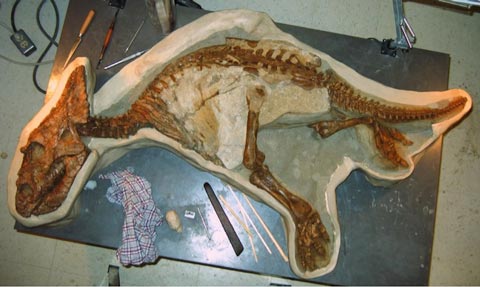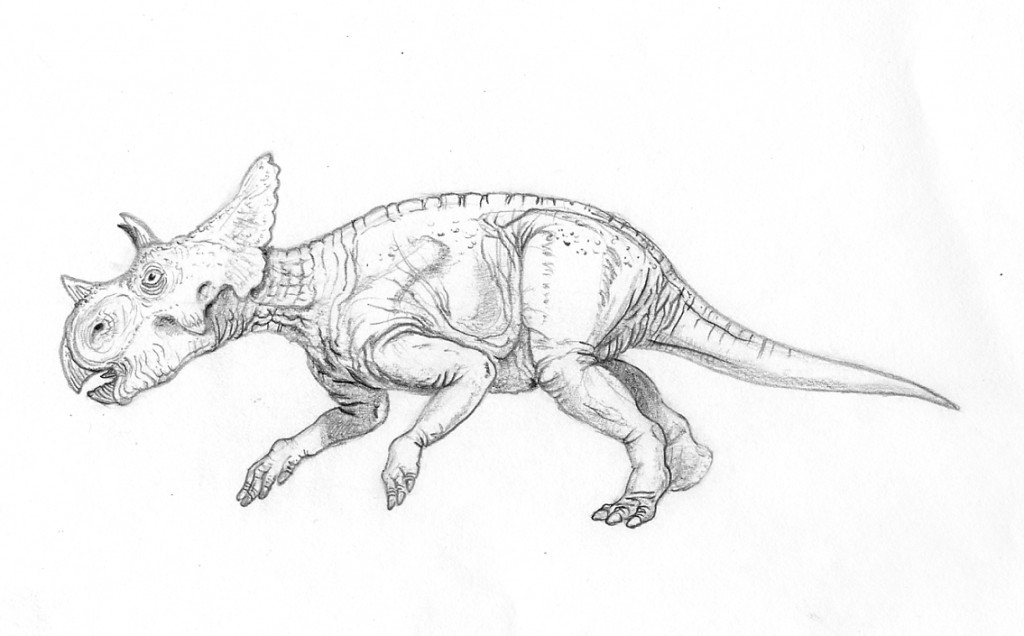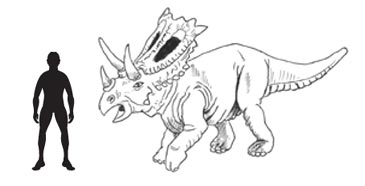Dinosaur Provincial Park Home to a Baby Chasmosaurus
The word “cute” is rarely used to describe a member of the Dinosauria, but a team of scientists have discovered the nearly complete fossilised remains of a baby horned dinosaur, a chasmosaurine toddler and it is providing palaeontologists with an insight into how dinosaurs changed as they grew.
Baby Chasmosaurus
Finding the fossilised remains of a young dinosaur is exceptionally rare, as Professor Phil Currie of the University of Alberta (Canada), explained:
“The big ones just preserve better. They don’t get eaten, the don’t get destroyed by animals. You always hope that you’re going to find something small and that it will turn out to be a dinosaur.”
A field team was examining a dig site in the famous Dinosaur Provincial Park (Alberta), when Professor Currie thought he had found part of a turtle shell sticking out of the hillside. On closer inspection it turned out to be elements from the bony frill of a baby horned dinosaur. A number of isolated bones from small, juvenile ceratopsians had been found previously in the Dinosaur Provincial Park, but single bones are not much help to the scientists who want to learn how dinosaur body proportions changed as these reptiles grew up.
An Almost Complete Specimen
Having excavated the entire specimen, virtually complete with just the front limbs missing, in fact the skeleton was so well preserved that the pebble-like skin pattern of this dinosaur had been preserved as an impression on the surrounding rock matrix, the dinosaur was identified as a Chasmosaurus belli, a distant relative of the better known Triceratops.
The Baby Chasmosaurus Dinosaur Fossil (C. belli)
Picture credit: Philip J. Currie, Robert Holmes, Michael Ryan Clive Coy, Eva B. Koppelhus
Around Three Years of Age
The various tools placed around the fossil give an idea of scale. The research team estimate that this little dinosaur was about three years old when it died. It would have taken another fifteen years or so to reach maturity. If it had made it into adulthood it would have been over five metres long and weighed more than an Indian elephant. Although, still a baby this youngster was over 1.5 metres in length. The sediments in which the fossil material had been preserved represent a watery environment and the lack of any evidence of predation or scavenging suggests this little dinosaur probably drowned and then the body was buried relatively quickly.
Professor Currie speculated:
“I think it may have just gotten trapped out of its league in terms of water current.”
Apart from being cute, this newly discovered specimen will help palaeontologists understand a little more about the ontogeny (growth) of ornithischian dinosaurs. An examination of the baby chasmosaur’s bony frill has revealed that it looked very different compared to a mature adults.
Ontogeny in the Ceratopsia
Intriguingly those limbs that are present reveal that the leg proportions don’t change much as the animals grow. Tyrannosaurids such as the infamous T. rex, look very gangly as juveniles. The legs are disproportionately longer as juveniles than they are when they are adults. Presumably, long legs in the youngsters help them to keep up with the adults in the pack, or perhaps to avoid being eaten by other predators.
An Illustration of a Baby Ceratopsian Dinosaur
Picture credit: Mike Fredericks/Everything Dinosaur
Comparing the new chasmosaurian specimen to theropods, Professor Currie commented on the likely differences between how herbivores and carnivores grew up.
He added:
“In chasmosaurians, the proportions are essentially the same, which probably means the adults were probably never moving that fast. There was never priority for these animals to run to keep up with the adults.”
It is very likely that this youngster would have stayed close to the adults in its herd, the larger, heavier animals would have acted as a considerable deterrent should any theropod fancy snacking on a baby Chasmosaurus. It is likely that the specimen will be put on public display once the preparation work has been completed.
An Illustration of an Adult Chasmosaurus (C. belli)
Picture credit: Everything Dinosaur
For articulated models and replicas of horned dinosaurs including chasmosaurs: Beasts of the Mesozoic Articulated Dinosaurs.









Hello!
The Daily Mail online would like to use the images from this story on our website, with credits and link back to your site. Would you be able to give permission please, or provide contact details of the owners so we can contact them direct?
Many thanks,
Janet
One of our team members is sorting this out for you. Thank you for your enquiry.